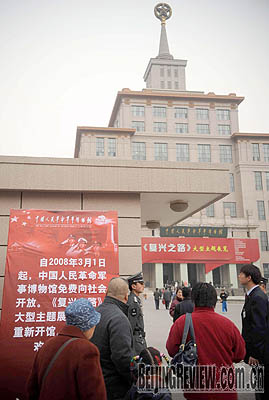|

HISTORY BUFFS: Culture and history enthusiasts make their way to the Military Museum of the Chinese People’s Revolution, opened to the public free of charge on March 1 Photo by LUO XIAOGUANG
"To be honest, I was a little surprised to see there was not a long line waiting in front of the museum as I had expected," said Yuan Hong, a Beijing resident and also a military fan. Yuan was visiting the Military Museum of the Chinese People's Revolution in Beijing on May 1, the first day of China's three-day Labor Holiday.
"I had worried that I might have to wait for an hour or two to get into the free museum, but there was no queue at all, neither was there much noise inside the museum," Yuan told Beijing Review.
Yuan was experiencing the first day of a new free-entry scheme at the museum, which stands on the north side of the central section of Fuxing Road, designed to encourage more people to visit museums and memorials.
Another 33 museums in Beijing, including the Capital Museum, 20 museums in northwest Gansu Province and nine museums in Guangdong Province also cancelled entry fees as of March 28, and as the scheme has become more widely known the number of visitors has risen dramatically.
Under the government's plan, the number of free-entry museums across the country reached 600 by April 1 this year and another 800 will be free by next year.
"I believe the free admission policy will attract more people to enter museums, which will help improve the public's cultural awareness," said Xiao Yonggao, speaking to a local newspaper in Beijing. Xiao was a visitor from northeast China's Liaoning Province visiting Beijing's Capital Museum on the first day of free entry.
The operating expenses of all national museums and memorial halls will be covered from the central budget, while institutions at the provincial level will be jointly supported by central and local budgets, according to Vice Minister of Finance Zhang Shaochun.
The Central Government will invest 1.2 billion yuan ($171 million) into free museums, memorial halls and patriotic educational bases, according to the Central Government's budget report in March.
"Free entry to museums and memorial halls must be guaranteed and should in no way be hampered by fund shortages," Zhang said.
The government issued a circular on January 23 saying that all museums, memorial halls and national patriotic education bases will offer free admission by 2009, excluding some cultural relics and historical sites.
China has more than 2,300 museums, which received 150 million people last year, according to Zhang Bai, Deputy Director of the State Administration of Cultural Heritage.
Wild crowds
Museum visitors have welcomed free entry, but the scheme has not come without problems. On the first day of free entry, the Military Museum of the Chinese People's Revolution received some 12,000 visitors, six times as many as on the same day last year. In the first month since March 1 the museum took in a total of 400,000 visitors, an average of 13,000 every day, while in the past before the free-entry movement, the museum received a daily 1,250 visitors, said Gao Yulin, a staff member with the news department of the museum.
"We had expected the sudden rush of people and prepared for that," said Gao, adding that the workload for the staff has been increased due to the rising number of visitors.
There was concern that the increase in numbers could cause damage to museums. It was reported that in Fujian Province at one museum taking part in the free entry scheme crowds crushed the gate and some exhibitions were damaged. The museum was closed as a result.
"When a museum is free, all groups of people from different classes can come to visit it. We can't choose who will be our audience, so what we should do is to enhance the management to take on the challenge," said Gao.
Adam Minter, an American writer in Shanghai showed his confidence in the free-entry scheme. "The ones likely to cause damage to the collections are a trifling minority compared to those who come because they want to see the art," he said in his blog titled Shanghai Scrap. "Curiosity-seekers will always be outnumbered by culture seekers. China will be no different, and I predict that the days of wild crowds roaming the permanent collections of China's state-level museums will soon be a memory."
The problem occurred during the first few days of the free-entry scheme in Fujian was an isolated case, while the general situation was good, said Zhang of the State Administration of Cultural Heritage.
Zhang emphasized that museums should boost their services, management and security facilities to meet the challenge that larger numbers of visitors will create. At the same time, on the part of the visitors, they should follow the regulations of the museums and behave properly when visiting them, he added. | 